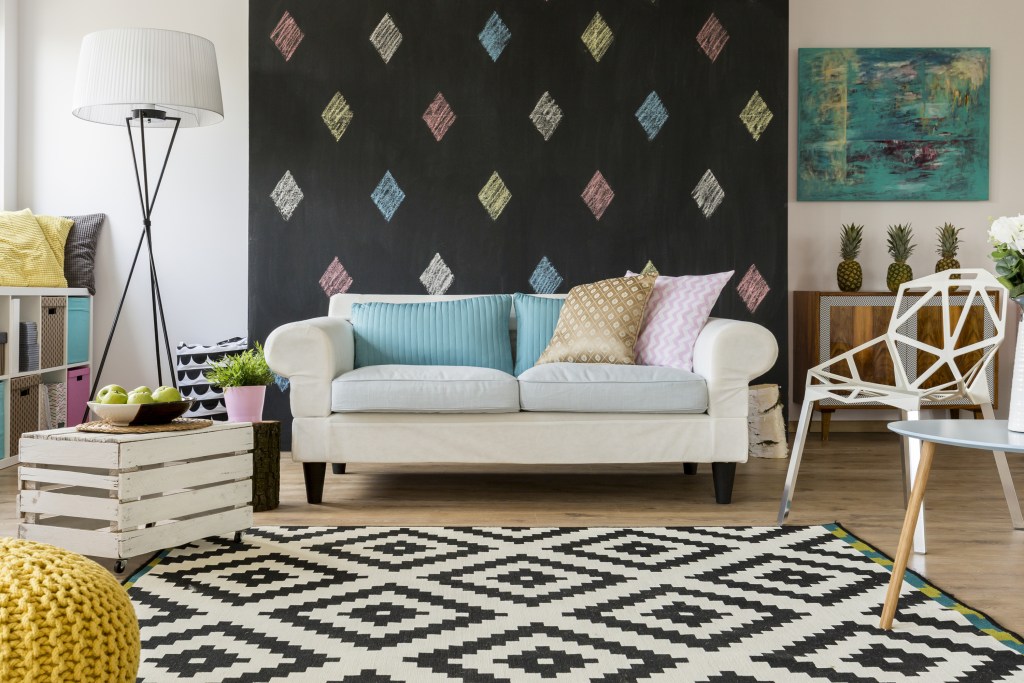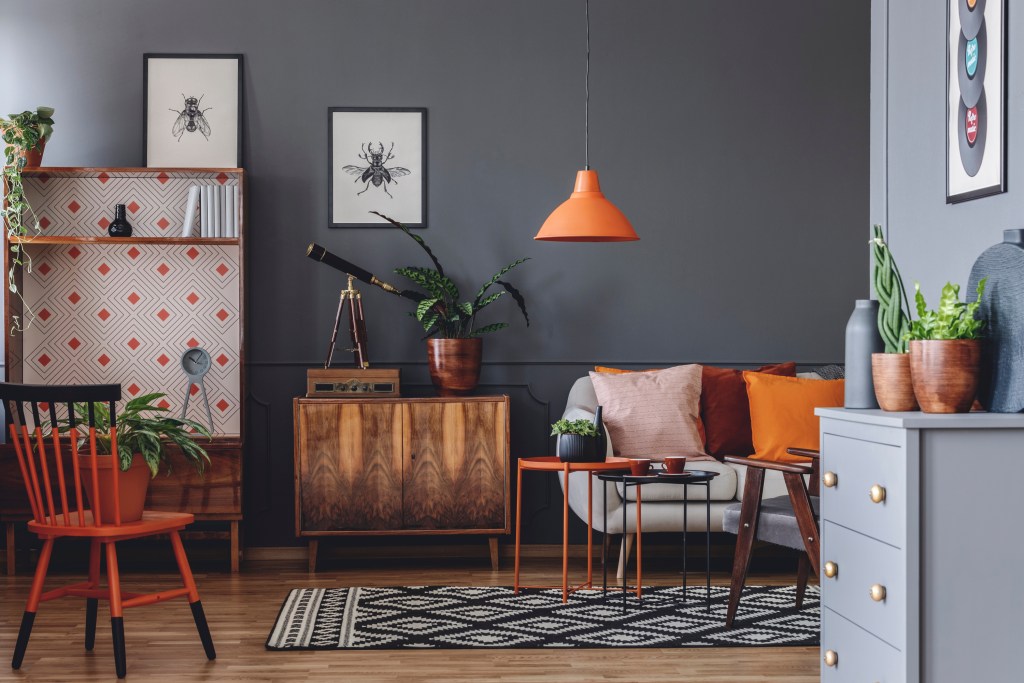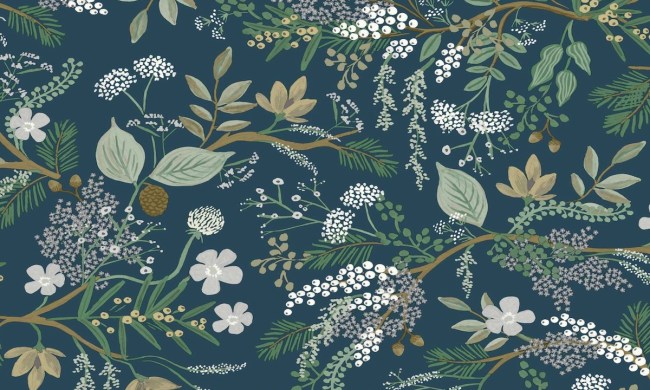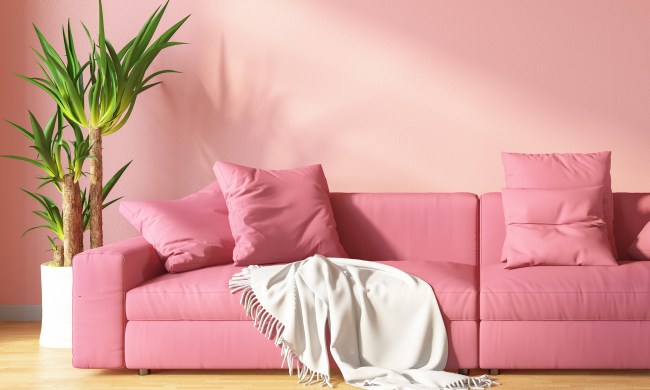There was once a time when you wouldn’t be caught dead decorating your home like your grandmother’s — but while we still want to leave her clear plastic sofa cover firmly in the past, the patterns, textures, and materials reminiscent of days spent with our grandparents have circled around to become cool again. We’re speaking, of course, about grandmillennial design. This style takes all of that vintage charm and repackages it in a modern, fresh, curated way.
Tired of stark minimalism? Want to embrace the comfort and coziness of trending home design? Grandmillennial design simultaneously feels new and old, offering a modern take on classic styles.

What is grandmillennial design?
The term “grandmillennial design” refers to a recent trend in which millennials (people in their late 20s and 30s) decorate their homes with furniture and accessories that used to be considered outdated. Think of your grandmother’s house, filled with dark brown furniture, slipcovers, embroidered throws, patterned pillows, and lots of ruffles, lace, and monograms. When young people decorate their homes that way, it’s grandmillennial design.
“I see that trend where traditional is coming back,” Evelyn Benatar, president of New York Interior Design Inc., noted. It’s reflected in homeowners’ choice of trimmings and window treatments and their focus on using floral prints, mixing patterns, and layering. The style is also sometimes referred to as “Granny chic.”
When people think of their grandparents’ homes, they often remember that they seemed cluttered. In traditional home design, several patterns were often included in a single room and layered. That’s a characteristic of grandmillennial design, but in a departure from the past, a tenet of this style is to not go overboard on stuff. Instead, while patterns and texture are embraced — as are vintage pieces — there’s a curated approach to clutter. The goal is also to make the house feel approachable, and not stuffy.

Grandmillennial blends old and new
Millennials put their own stamp on classic designs, often pairing vintage pieces with modern ones in the same room. “It’s a style where you mix modern pieces with things you might see in your grandma’s home,” Yoko Oda, owner and principal designer of Yoko Oda Interior Design, said. “We can safely say it’s a new traditional style.”
According to Marilyn Sygrove, president of Sygrove Associates Design Group Inc., “Grandmillenial style is a wonderful combination of old family heirloom-type pieces, such as a hand-crocheted Afghan throw, a needlepoint pillows, or a ‘dated’ fully upholstered olive-green armchair — items that trigger warm and fuzzy memories of one’s youth visiting Grandma.”
Sygrove continued, “Other trendy terms widely used have been ‘vintage,’ ‘cluttered,’ and ‘traditional,’ but now that the younger millennial generation is finding comfort and love in discovering these treasures for themselves and taking ownership, they are now aware of the interior that would be the gourmet equivalent of ‘chicken soup.’ It is quite wonderful!”
Jenni Warsitz, lead designer at By Design Interiors, also emphasized the way that grandmillennial style blends old and new. “To me, grandmillennial design is taking modern design elements and mixing them with older, antique, or even possibly family heirlooms into a cohesive design,” Warsitz said. “It has an eclectic feel!
“Grandmillennial is very niche, client-specific, but an interesting concept!” Warsitz added. “I like the versatile idea of marrying the ultra-vintage and modern design.”
Sustainability plays a big role in grandmillennial style
One of the core principles of grandmillennial design is to find and reuse old items to decorate a home. According to Oda, “The linguistic nuance right now is that millennials and young people do not purchase those old items; they like to cheaply find, recycle, and reuse those things. If those old things are purchased, such as costly antiques, I don’t think it would be called grandmillennial style.”
Erika Barczak, senior designer at By Design Interiors, agreed. “There’s a conscious effort to be less wasteful — either by using recycled materials or finding unique vintage/antique treasures,” Barczak noted. “I love incorporating a beautiful antique or vintage item into a space. Reupholstering a fantastic vintage chair gives the chair new life but also adds a bit of old soul to your space. I’m also super guilty of gold-leafing items – it completely changes the look!”
Why has grandmillennial design become so popular?
When one particular style is dominant for a period of time, the next generation invariably rebels against it and takes things in a different direction. Young people who were raised in houses with minimalist designs and mass-produced furniture are decorating their own homes with traditional elements and filling them with patterns and texture to create highly personalized spaces.
For example, millennials often incorporate their own collections of china or other items in their interior design. Sygrove noted that grandmillennial style is most definitely not about “faux mid-century, mass-produced furniture, stark and minimalist interiors, sterile and severe ‘less is more’ interiors.”
“Design repeats itself,” Warsitz noted. “Over the past few years, we have gone from maximalism, to vintage, to farmhouse, to more earthy, organic, and simple designs. I think right now we are in the middle stages and I’m excited to see what evolves.”
Benatar agreed. “Everything is cyclical,” she stated. “It’s what we were doing 25 years ago. It’s just coming back. That’s all.”
Barczak pointed out that younger generations don’t just bring back older styles; they also improve upon them:
“Design trends have an amazing way of reinventing themselves. I don’t think it’s about embracing outdated trends, but taking design that was good at one point in time and making it better because technology and style has evolved.”
Makers of home decor have changed some of their offerings to meet demand. According to Barczak, “Fabric manufacturers are recoloring vintage prints with fresh colors and making fabrics more durable. Wallpaper is more tactile, more durable — sometimes even washable and easier to remove. Washable slipcovers make sense when you have children or pets running around.”
Barczak pointed out that for homeowners, durability is critical. “I once had a client who was telling me about her wedding. She wanted to be different, so she asked to have a sapphire engagement ring instead of a diamond. But then she said, ‘You know why we use diamonds in engagement rings? Because they’re durable! You can wear it every day and not worry about it. I can’t wear my sapphire every day or I’ll ruin it.’ We reinvent and restyle the diamond over and over again… but we keep using diamonds because it will last forever. I think this same concept can be applied to so many homes and furnishing items.”
How can you incorporate grandmillennial design in your home?
Grandmillennial style is versatile, but Charlie A. Bolivar, interior designed at Charlie’s Designs LLC, pointed out that it won’t work in every house. “To me, the meaning of grandmillennial style is an old way of designing a home. But the home has to be able to support that style,” he noted. “Ideally, it should be an older home, probably from the 1970s or 1980s, but it also has to have old school charm to be able to work with this type of design.”
He also pointed out that homeowners must be careful not to go overboard. “It’s typically a very heavy way of designing a space, like in the ’80s or ’90s, when we used a lot of really heavy prints in wallpapers, fabrics, tapestries — even the artwork was very large and with old, heavy frames. Almost everything had a very heavy pattern, and rooms were intentionally designed to be very cluttered,” he said. “Make no mistake — some of those designs can be beautiful. However, it can also turn out very badly if it’s not done well!”
According to Bolivar, to make grandmillennial style work in your home, you should aim to keep things relatively simple. “The best idea is to bring together those patterns and styles in a way that is still practical and livable without making the space too cluttered,” Bolivar explained. “The design should be sophisticated and elegant, for example, by really leveraging a few specific pieces that are combined with other, less heavy textures to avoid clutter.”
Living room
If you’d like to bring grandmillennial design to your living room, you can cover the walls with wallpaper and decorate the room with old family photos, traditional artwork, and antiques. When it comes to furniture, keep an open mind. A sofa or table that isn’t much to look at right now may have potential. You may be able to transform it by having it refurbished or by adding a slipcover or pillows.
“Don’t be in a rush to throw away a furniture piece you’ve inherited,” Barczak advised. “Find someone who has a good eye to help you refresh that piece and incorporate it into your space.”
Kitchen
To bring grandmillennial design to your kitchen, Sygrove suggested including “vintage cookie jars, canisters, a large-scale framed vintage food poster, vibrant wall colors, [and] pendant lights.” Benatar recommended using a “lot of color in cabinetry and backsplashes. No more white kitchens. It’s a classic, but I think it’s over as a trend.”
Oda suggested incorporating vintage materials and accessories in the kitchen. For example, you can reuse an “old-fashioned backsplash/countertops, …old-fashioned faucets, …[and an] old sink.”
Bedroom
Sygrove suggested several ways to embrace grandmillennial design in your bedroom. For example, you can incorporate “ruffled shams and bed skirts, layers of randomly patterned pillows, floral sheets and layers of drapery, fully upholstered lounge chair and ottoman with reading lamp — space permitting — or an old linen chest, or wood-framed black and white or faded photos of one’s ancestors.”
Oda provided additional suggestions, such as the mirrors or nightstands you inherited from your grandparents and old-fashioned ruffled bedding.
When decorating your bedroom, Benatar recommends that you “start with a pattern you love, take another pattern, use a lot of trim, incorporate some of the same colors, and pull in different patterns.”
Bathroom
If you want to try using grandmillennial design in your bathroom, Sygrove recommended: “towels with lace trim and monograms, baskets filled with potpourri, colorful ceramic wall tile that has accessories, pieces such as base moldings, top cap, or pencil molding, and classic traditional geometric mosaic tile.”
Oda suggested adding “Grandma’s mirror over [the] vanity, Grandma’s baskets for storage, [and] Grandma’s fabric for [a] vanity skirt/shower curtain.”
Is grandmillennial design a passing fad or a long-term trend?
Several designers believe that grandmillennial design will be around for the foreseeable future. “I think traditional is here to stay for a while because everything has been so starkly modern for a long time,” Benatar stated.
Bolivar agreed, but he expects grandmillennial style to change over time. “I firmly believe that this style will always be around and will continue to evolve by incorporating new in-home technology and elements of other design styles, as people continue to design their living spaces in an eclectic style,” he noted.
Sygrove predicts that grandmillennial design will become simplified. “I would expect it to be pared down eventually to something very selective and curated, rather than a whole eclectic environment,” she stated. “I believe they will simplify and tend to highlight one or two few favorite pieces that are standouts and special.”
Your home should reflect your personality and should also fit your lifestyle. If you’re feeling nostalgic, consider including some antique furniture, family heirlooms, and traditional accessories to embrace the grandmillennial trend. Include both old and new elements to keep things balanced and create your own unique style.






